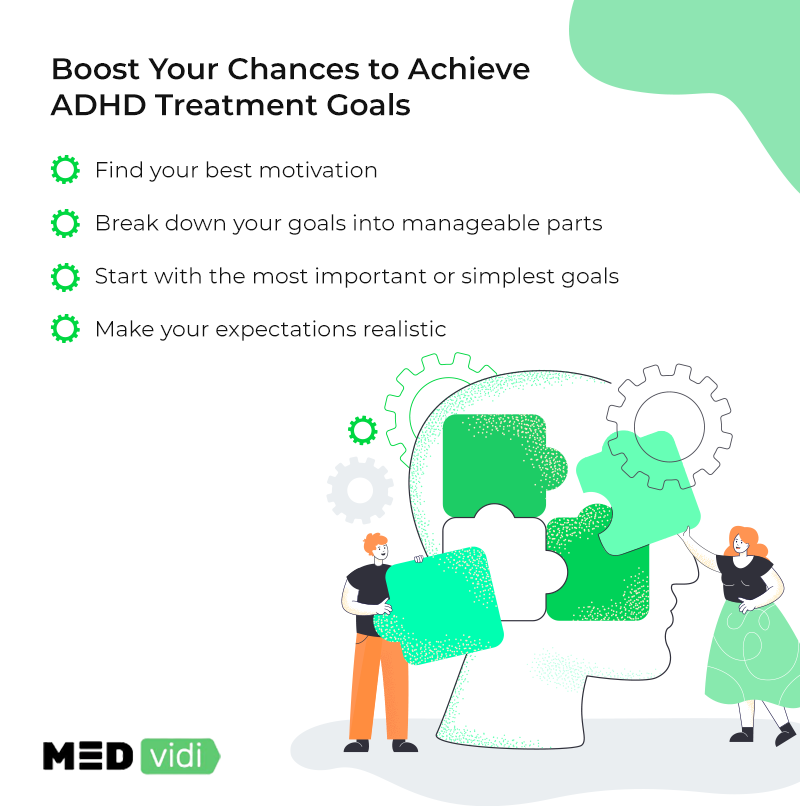ADHD is a chronic condition, often starting in childhood and going all the way to adulthood. And even though much focus is on the treatment of children, with
However, before even choosing the treatment options and discussing the pros and cons of ADHD medications and suitable types of therapy, it is important to set the right treatment goals.
Generally, the treatment plan, goals, and objectives for ADHD aim to ensure the patient has fewer of the condition’s symptoms while optimizing their ability to cope with the rest. Still, the treatment goals for ADHD should be highly individualized to reflect the person’s needs. They help define the treatment structure and are used to gauge its success. So, let’s know more about setting such goals efficiently.
Setting the Goals for ADHD Treatment
To set ADHD treatment goals for adults, the caregivers and patients themselves should go beyond the standard aims. Instead of willing to just improve symptoms, one can work with measurable outcomes that are meaningful to the individual. Also, ADHD treatment goals for adults should follow the SMART protocol, i.e., they should be:
- Specific. Patients should have clear and detailed goals they can state or write.
- Measurable. Patients should be able to measure the progress made towards attaining the desired result.
- Attainable. The patient and the caregivers should find the goal worth pursuing and be reachable.
- Realistic. The goals should be grounded in reality in what you can achieve and attain.
- Timely. The goals should not be far off in the future but rather be attainable in a meaningful period.
Tips for Setting Treatment Goals for ADHD in Adults and Achieving Them Faster
To get started in goal-setting, a patient should consider the following tips:
- Identify the motivations. Patients cannot follow goals unless truly motivated, so they should first identify what they want to correct most.
- Arrange the goals in order of priority. The patient should prioritize which goals to follow, starting with the most important ones and the ones chronologically required while keeping in mind motivation.
- Temper expectations. Expectations should be guided by the realistic aspect of SMART goals. Setting high expectations and then coming short will lead to disappointment. On the other hand, lowering the expectations to a more realistic level allows the patient to attain them and earn momentum and further motivation.
- Break down goals into manageable parts. A significant part of having measurable goals is breaking them into smaller ones, for example, for daily or weekly assessments.
- Choose quick progression. Quick success breeds confidence and belief in your plan. So, go for goals you can quickly achieve, using them as practice for the goals that will take longer to succeed.
Examples of Adult ADHD Treatment Goals
Adult treatment goals mostly focus on improving professional and social life. The goals will fall in areas like:
- Relationships. One should learn how to form and keep healthy
relationships[2] with family, friends, and colleagues. - Work assignments. Whether school work or professional roles, one should follow through with assigned tasks and get better at remembering their scope and completing them in time
- Communication. Patients should aim to get better at conversations but, more importantly, have better self-awareness of their traits, actions, and feelings.
- Behavior. They should also look to build appropriate behavior in different contexts with minimal prompts or reminders.
As such, examples of ADHD treatment goals include:

Professional Goals
- Complete a specific number of daily tasks, adding up to over ¾ of your work done in a week.
- Recall all details of a project or assignment and their deadlines using X number of reminders (one can use resources like taking notes).
- Start to work daily on time with X number of reminders.
- Record X number of achievements at work after a month.
- Learn X number of skills at work after two or three months.
- Hold a job for 6 months to a year without wishing to change.
- Perform better in job interviews.
Long-term goals could include earning promotions, performing well at an appraisal, or finding an even better job.
Social Goals
Individuals with ADHD often face unique challenges in navigating social situations. Here are some
- Have conversations without interrupting others with X number of reminders.
- Stick to a morning routine from waking up to work time.
- Display appropriate coping behavior when you are upset.
- Reduce workplace conflicts to X number per week.
- Intentionally learn and remember details and aspects of your loved ones.
- Improve your self-confidence in undertaking and completing tasks.
- Remember commitments made to friends and family members.
- Reduce fidgeting with only x reminders.
In Conclusion
The treatment goals will have to change with each successful progression you make. The benefit of measurable treatment goals for ADHD is that they can tell you if your current treatment plan is working or not and the areas you need to focus on. It also adds purpose and intention to your treatment plan, increasing its effectiveness. More crucially, it allows you to take back control of your life affairs, improving the quality of your life and control of your executive function. If you are ready to improve your ADHD symptoms and achieve results related to your day-to-day activities and goals, contact MEDvidi today to start ADHD treatment!













